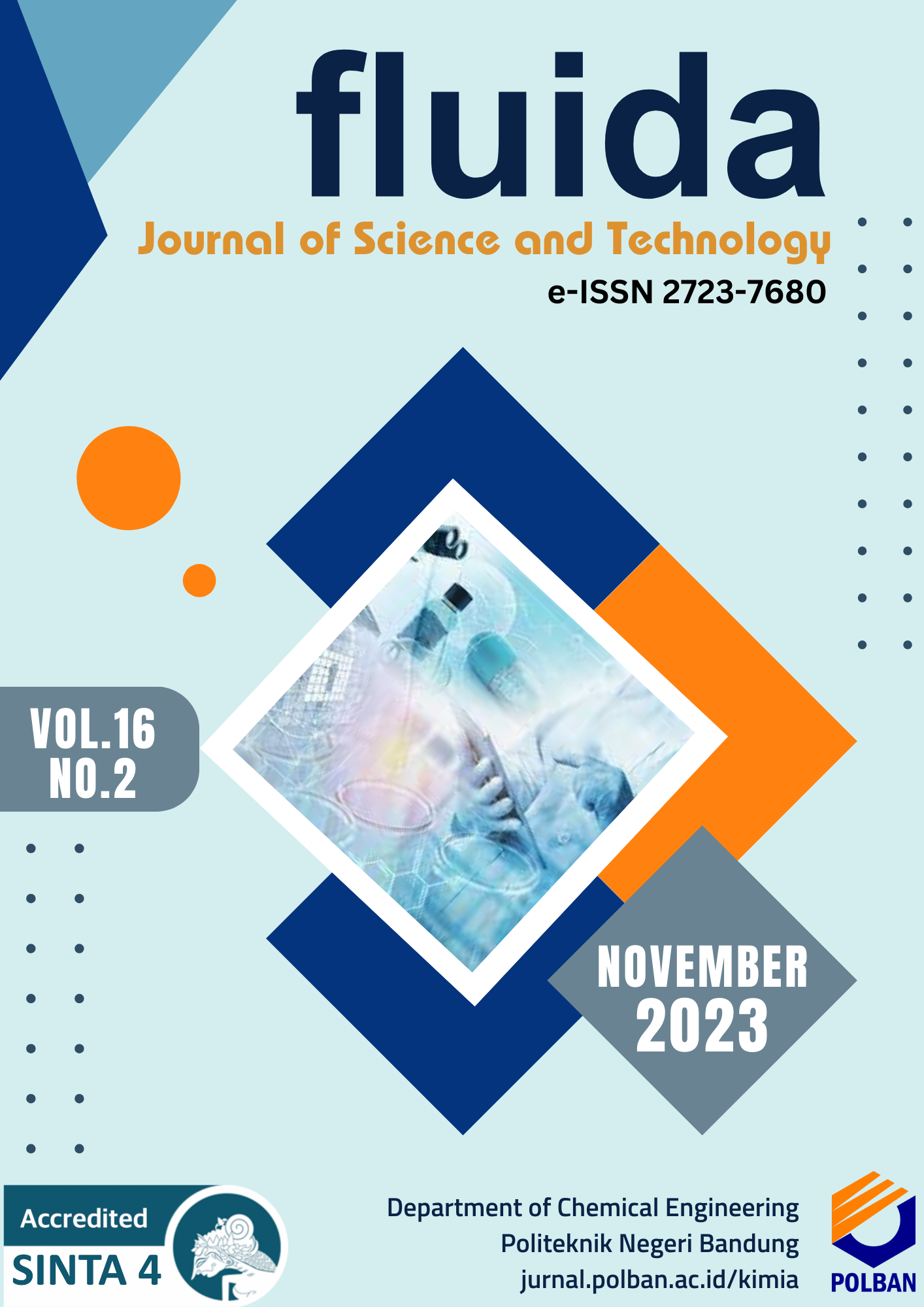Effect of Hydrolysis and Amount of Yeast on Banana Peel Fermentation into Bioethanol
Main Article Content
Abstract
Recently, renewable energy sources are needed to meet human energy needs, one of which is bioethanol. Bioethanol can be made from banana peels. Banana peel contains starch which has the potential to be converted into bioethanol through fermentation. There are factors that affect fermentation including the number of microorganisms and glucose levels. One method to increase glucose levels is hydrolysis. The purpose of this study was to determine the effect of hydrolysis and the amount of yeast on bioethanol levels in banana peel fermentation. The research variables used were hydrolyzed and non-hydrolyzed banana peel substrates, as well as variations in the amount of yeast as much as 3 grams; 4.5 grams; and 6 grams. From this research, it was found that hydrolysis causes an increase in glucose levels in the substrate due to the conversion of starch to glucose. Increased glucose levels can affect the yield of bioethanol. The bioethanol content of the hydrolyzed substrate fermentation is 9%-9.5% greater than the bioethanol content of the non-hydrolyzed substrate fermentation of 3%-3.5%. The difference in the amount of yeast used in banana peel fermentation has an effect on the bioethanol content but not significantly enough because the amount of yeast will depend on the glucose content in the substrate.
Downloads
Article Details
An author who publishes in the FLUIDA journal agrees to the following terms:
- Author retains the copyright and grants the journal the right of first publication of the work simultaneously licensed under the Creative Commons Attribution-ShareAlike 4.0 License that allows others to share the work with an acknowledgement of the work's authorship and initial publication in this journal
- Author is able to enter into separate, additional contractual arrangements for the non-exclusive distribution of the journal's published version of the work (e.g., post it to an institutional repository or publish it in a book) with the acknowledgement of its initial publication in this journal.
- Author is permitted and encouraged to post his/her work online (e.g., in institutional repositories or on their website) prior to and during the submission process, as it can lead to productive exchanges, as well as earlier and greater citation of the published work (See The Effect of Open Access).
Read more about the Creative Commons Attribution-ShareAlike 4.0 Licence here: https://creativecommons.org/licenses/by-sa/4.0/.
References
[2] N. Hossain et al., “Bioethanol production from forest residues and life cycle cost analysis of bioethanol-gasoline blend on transportation sector,” J. Environ. Chem. Eng., vol. 9, no. 4, p. 105542, 2021, doi: 10.1016/j.jece.2021.105542.
[3] N. Anita, B. Admadi H, and I. Arnata, “Optimasi Konsentrasi Enzim Amiloglukosidase dan Saccharomyces cerevisiae dalam Pembuatan Bioetanol dari Ubi Jalar (Ipomoea batatas L) Varietas Daya dengan Proses Sakarifikasi Fermentasi Simultan (SFS),” J. Rekayasa dan Manaj. Agroindustri, vol. 3, no. 2, 2015.
[4] P. Zhang, R. L. Whistler, J. N. Bemiller, and B. R. Hamaker, “Banana starch: Production, physicochemical properties, and digestibility - A review,” Carbohydr. Polym., vol. 59, no. 4, pp. 443–458, 2005, doi: 10.1016/j.carbpol.2004.10.014.
[5] N. P. S. Ayuni and P. N. Hastini, “Serat Sabut Kelapa Sebagai Bahan Kajian Pembuatan Bioetanol Dengan Proses Hidrolisis Asam,” JST (Jurnal Sains dan Teknol., vol. 9, no. 2, pp. 102–110, 2020, doi: 10.23887/jstundiksha.v9i2.29035.
[6] N. Hidayat, S. Prabowo, A. Rahmadani, Marwati, and A. Emmawati, This PDF document was edited with Icecream PDF Editor . Upgrade to PRO to remove watermark. 2020.
[7] C. E. Wyman and N. D. Hinman, “Ethanol,” Appl. Biochem. Biotechnol., vol. 24–25, no. 1, pp. 735–753, Mar. 1990, doi: 10.1007/BF02920291.
[8] D. T. Retno and W. Nuri, “Pembuatan Bioetanol dari Kulit Pisang,” Pros. Semin. Nas. Tek. Kim. “Kejuangan” Pengemb. Teknol. Kim. untuk Pengolah. Sumber Daya Alam Indones., pp. E11-1-E11-7, 2011.
[9] W. Wusnah, S. Bahri, and D. Hartono, “Proses Pembuatan Bioetanol dari Kulit Pisang Kepok (Musa acuminata B.C) secara Fermentasi,” J. Teknol. Kim. Unimal, vol. 8, no. 1, p. 48, 2019, doi: 10.29103/jtku.v8i1.1915.
[10] Z. N. Wardefisni, N. A. Nafira, and K. N. Wahyusi, “Studi Kesesuaian Katalisator Asam Pada Proses Study on the Suitability of Acid Catalizators in the Process of Making Bioethanol From Kulit,” no. September, pp. 1–5, 2020.
[11] M. Luqman Hakim, E. Dwi Hastuti, S. Parman Laboratorium Biologi Struktur dan Fungsi Tumbuhan, and J. Biologi, “Pengaruh Pemberian Ensim Amilase terhadap Kadar Bioetanol dari Limbah Sagu Padat,” J. Biol., vol. 4, no. 1, pp. 17–24, 2015.
[12] P. Mardina, H. A. Prathama, and D. M. Hayati, “Pengaruh Waktu Hidrolisis Dan Konsentrasi Katalisator Asam Sulfat Terhadap Sintesis Furfural Dari Jerami Padi,” Konversi, vol. 3, no. 2, p. 1, 2016, doi: 10.20527/k.v3i2.158.
[13] N. K. A. Dewi, A. Hartiati, and B. A. Harsojuwono, “PENGARUH SUHU DAN JENIS ASAM PADA HIDROLISIS PATI UBI TALAS (Colocasia esculenta L. Schott) TERHADAP KARAKTERISTIK GLUKOSA,” J. Rekayasa Dan Manaj. Agroindustri, vol. 6, no. 4, p. 307, 2018, doi: 10.24843/jrma.2018.v06.i04.p05.
[14] E. Praputri, E. Sundari, F. Firdaus, and S. Sofyan, “Penggunaan katalis homogen dan heterogen pada proses hidrolisis pati umbi singkong karet menjadi glukosa,” J. Litbang Ind., vol. 8, no. 2, p. 105, 2018, doi: 10.24960/jli.v8i2.4189.105-110.
[15] I. Febriana, Zurohiana, A. Zikri, and S. Hatina, “Pengaruh Konsentrasi Ragi Roti (Saccharomyces Cereviseae) Dan Lama Fermentasi Dalam Pembuatan Bioetanol Menggunakan Kulit Pisang,” Distilasi, vol. 3, no. 1, pp. 1–7, 2018.
[16] U. Pato and U. Riau, Buku Mikrobiologi Industri Pertanian, no. September. 2019.
[17] E. M. Widyanti, D. Bintang, and I. Moehadi, “Proses Pembuatan Etanol Dari Gula Menggunakan Saccharomyces Cerevisiae Amobil,” Metana, vol. 12, no. 2, pp. 31–38, 2016, [Online]. Available: http://ejournal.undip.ac.id/index.php/metana.
[18] M. P. Simanjuntak, Elia; Chairul; Sembiring, “JOM FTEKNIK Volume 2 No.1 Februari 2015,” JOM FTEKNIK Vol. 2 No.1 Februari 2015 1, vol. 2, pp. 1–6, 2013.
[19] J. Litya and I. R, “Pembuatan Bioetanol Dari Tebu Dan Ubi Jalar serta Pengujian Pada Motor Bakar Torak,” Teknik, vol. 21, no. 2, pp. 45–56, 2014.

